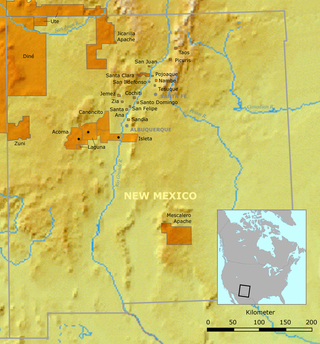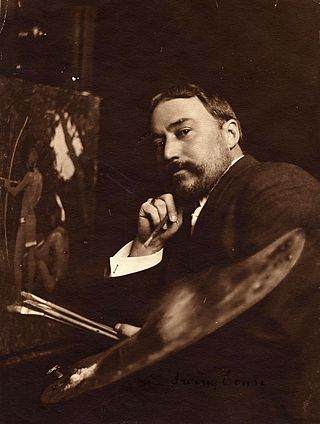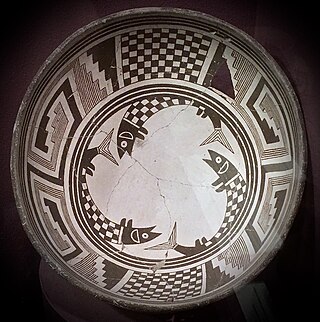
The Puebloans, or Pueblo peoples, are Native Americans in the Southwestern United States who share common agricultural, material, and religious practices. Among the currently inhabited Pueblos, Taos, San Ildefonso, Acoma, Zuni, and Hopi are some of the most commonly known. Pueblo people speak languages from four different language families, and each Pueblo is further divided culturally by kinship systems and agricultural practices, although all cultivate varieties of maize.

Eanger Irving Couse was an American artist and a founding member and first president of the Taos Society of Artists. Born and reared in Saginaw, Michigan, he went to New York City and Paris to study art. While spending summers in Taos, New Mexico, he began to make the paintings of Native Americans, New Mexico, and the American Southwest for which he is best known. He later settled full time in Taos.

Kewa Pueblo is a federally-recognized tribe of Native American Pueblo people in northern New Mexico, in Sandoval County southwest of Santa Fe. The pueblo is recorded as the Santo Domingo Pueblo census-designated place by the U.S. Census Bureau, with a population of 2,456 at the 2010 census.

San Ildefonso Pueblo is a census-designated place (CDP) in Santa Fe County, New Mexico, United States, and a federally recognized tribe, established c. 1300 C.E. The Pueblo is self-governing and is part of the Santa Fe, New Mexico Metropolitan Statistical Area. The population was 524 as of the 2010 census, reported by the State of New Mexico as 1,524 in 2012, and there were 628 enrolled tribal members reported as of 2012 according to the Department of the Interior. San Ildefonso Pueblo is a member of the Eight Northern Pueblos, and the pueblo people are from the Tewa ethnic group of Native Americans, who speak the Tewa language.

The Zuni are Native American Pueblo peoples native to the Zuni River valley. The Zuni people today are federally recognized as the Zuni Tribe of the Zuni Reservation, New Mexico, and most live in the Pueblo of Zuni on the Zuni River, a tributary of the Little Colorado River, in western New Mexico, United States. The Pueblo of Zuni is 55 km (34 mi) south of Gallup, New Mexico. The Zuni tribe lived in multi level adobe houses. In addition to the reservation, the tribe owns trust lands in Catron County, New Mexico, and Apache County, Arizona. The Zuni call their homeland Halona Idiwan’a or Middle Place. The word Zuni is believed to derive from the Western Keres language (Acoma) word sɨ̂‧ni, or a cognate thereof.

Acoma Pueblo is a Native American pueblo approximately 60 miles (97 km) west of Albuquerque, New Mexico, in the United States. Four communities make up the village of Acoma Pueblo: Sky City, Acomita, Anzac, and McCartys. These communities are located near the expansive Albuquerque metropolitan area, which includes several large cities and towns, including neighboring Laguna Pueblo. The Acoma Pueblo tribe is a federally recognized tribal entity, whose historic land of Acoma Pueblo totaled roughly 5,000,000 acres (2,000,000 ha). Today, much of the Acoma community is primarily within the Acoma Indian Reservation. Acoma Pueblo is a National Historic Landmark.

The Tewa are a linguistic group of Pueblo Native Americans who speak the Tewa language and share the Pueblo culture. Their homelands are on or near the Rio Grande in New Mexico north of Santa Fe. They comprise the following communities:

Native American pottery is an art form with at least a 7500-year history in the Americas. Pottery is fired ceramics with clay as a component. Ceramics are used for utilitarian cooking vessels, serving and storage vessels, pipes, funerary urns, censers, musical instruments, ceremonial items, masks, toys, sculptures, and a myriad of other art forms.

Hovenweep National Monument is located on land in southwestern Colorado and southeastern Utah, between Cortez, Colorado and Blanding, Utah on the Cajon Mesa of the Great Sage Plain. Shallow tributaries run through the wide and deep canyons into the San Juan River.
Rainbird, Rain Bird or Rainbirds may refer to:

The Zia or Tsʾíiyʾamʾé are an indigenous nation centered at Zia Pueblo (Tsi'ya), a Native American reservation in the U.S. state of New Mexico. The Zia are known for their pottery and use of the sun symbol. They are one of the Keres Pueblo peoples and speak the Eastern Keres language.

Maria Poveka Montoya Martinez was a Native American artist who created internationally known pottery. Martinez, her husband Julian, and other family members, including her son Popovi Da, examined traditional Pueblo pottery styles and techniques to create pieces which reflect the Pueblo people's legacy of fine artwork and crafts. The works of Maria Martinez, and especially her black ware pottery, survive in many museums, including the Smithsonian, the Metropolitan Museum of Art, the Denver Art Museum, and more. The Penn Museum in Philadelphia holds eight vessels – three plates and five jars – signed either "Marie" or "Marie & Julian".

Lucy Martin Lewis was a Native American potter from Acoma Pueblo, New Mexico. She is known for her black-on-white decorative ceramics made using traditional techniques.
Margaret Gutierrez and Luther Gutierrez (1911–1987) were a brother and sister team of Native American potters from Santa Clara Pueblo, New Mexico, United States. They descended from several generations of potters and continue the polychrome style of painting made famous by their parents Lela and Van Gutierrez. At age twelve, Margaret began apprenticing as a potter with her mother. Luther's father taught him where to find, and how to process the clay. Margaret and Luther began making pottery together in the 1960s.
The Native Writers' Circle of the Americas (NWCA) is an organization of writers who identify as being Native American, First Nations, or of Native American ancestry.

The Millicent Rogers Museum is an art museum in Taos, New Mexico, founded in 1956 by the family of Millicent Rogers. Initially the artworks were from the multi-cultural collections of Millicent Rogers and her mother, Mary B. Rogers, who donated many of the first pieces of Taos Pueblo art. In the 1980s, the museum was the first cultural organization in New Mexico to offer a comprehensive collection of Hispanic art.

The Pueblo II Period was the second pueblo period of the Ancestral Puebloans of the Four Corners region of the American southwest. During this period people lived in dwellings made of stone and mortar, enjoyed communal activities in kivas, built towers and dams for water conservation, and implemented milling bins for processing maize. Communities with low-yield farms traded pottery with other settlements for maize.

The Pueblo IV Period was the fourth period of ancient pueblo life in the American Southwest. At the end of prior Pueblo III Period, Ancestral Puebloans living in the Colorado and Utah regions abandoned their settlements and migrated south to the Pecos River and Rio Grande valleys. As a result, pueblos in those areas saw a significant increase in total population.

Art of the American Southwest is the visual arts of the Southwestern United States. This region encompasses Arizona, New Mexico, and parts of California, Colorado, Nevada, Texas, and Utah. These arts include architecture, ceramics, drawing, filmmaking, painting, photography, sculpture, printmaking, and other media, ranging from the ancient past to the contemporary arts of the present day.

Pueblo pottery are ceramic objects made by the indigenous Pueblo people and their antecedents, the Ancestral Puebloans and Mogollon cultures in the Southwestern United States and Northern Mexico. For centuries, pottery has been central to pueblo life as a feature of ceremonial and utilitarian usage. The clay is locally sourced, most frequently handmade, and fired traditionally in an earthen pit. These items take the form of storage jars, canteens, serving bowls, seed jars, and ladles. Some utility wares were undecorated except from simple corrugations or marks made with a stick or fingernail, however many examples for centuries were painted with abstract or representational motifs. Some pueblos made effigy vessels, fetishes or figurines. During modern times, pueblo pottery was produced specifically as an art form to serve an economic function. This role is not dissimilar to prehistoric times when pottery was traded throughout the Southwest, and in historic times after contact with the Spanish colonialists.















